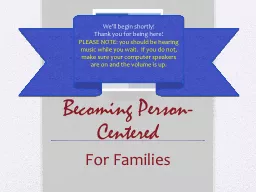

For Families Well begin shortly Thank you for being here PLEASE NOTE you should be hearing music while you wait If you do not make sure your computer speakers are on and the volume is up ID: 569608
Download Presentation The PPT/PDF document "Becoming Person-Centered" is the property of its rightful owner. Permission is granted to download and print the materials on this web site for personal, non-commercial use only, and to display it on your personal computer provided you do not modify the materials and that you retain all copyright notices contained in the materials. By downloading content from our website, you accept the terms of this agreement.
Slide1
Becoming Person-Centered
For Families
We’ll begin shortly!
Thank you for being here!
PLEASE NOTE: you should be hearing music while you wait. If you do not, make sure your computer speakers are on and the volume is up.Slide2
Becoming Person-Centered
For FamiliesSlide3
What we’ll talk about:
What it means to be
person-centered
Essential elements of Person-Centered Planning
Who needs a Person-Centered Plan?
How do people with disabilities participate?
How do you apply a person-centered plan to a systems plan?Slide4
Hang on to your hats, it’s going to be a bumpy ride. Slide5
What it means to be “person-centered”Slide6
Changing the way we speak
Shifts our own way of thinking and models the person-centered approach to others.
Jargon
Impersonal references
System-speak
Problem-focused
People!
Gifts!
Dreams & Desires!
Happiness!
Important TO!Slide7
Changing our perspectiveSlide8
Inviting others to enroll and contribute
“Circle of Support”
It’s about THEM, not us
We all have them!Slide9
Listening Deeply
Inviting ourselves to free our thoughts, abandon our preconceived notions about what we think they will say, and setting up a physical space that removes outside noises and distractions.
(PS – it ain’t easy.)Slide10
Essential Elements of a person-centered planSlide11
Essential Elements
Setting the stage & ground rules
Commitment
The Dream & the Gifts
Positive & Possible Goals
Checking in Halfway
Circle of Support
Planning for SustainabilitySlide12
Who needs a person-centered plan?Slide13
Who needs a PCP?
Expecting a transition in the future (2-5 years)
.Examples: transitioning out of school or supported environments (group home, mental health units/psychiatric care) changing home or employment situations, marriage/divorce, aging into supported living.
No specific transition, but seeking a new way to introduce themselves and communicate what’s important to and important for them.Slide14
How do people with disabilities participate?Slide15
Participation
Communication challenges do not mean a person does not have dreams and desires for themselves, or gifts to give to their community; nor does it remove their right to pursue them.
A PCP facilitator uses the person’s own level and method of communicating to drive the conversation, and seeks permission for those closest to them to represent their voice.
Loved ones must work thoughtfully to ensure that they are truly representing the person and not themselves.
Examples: posters,
powerpoints
, visual boards, video clips, other’s voicesSlide16
Participation
Challenge:
Invite others to share in creating the voice for your child if they need support. Be very thoughful about how you are asking:
DON’T ask “what do you think is my child’s dream?”
DO ask “describe to me a day that you remember, when my child was very happy? Smiling, laughing, enjoying themselves, etc.” AND “what kinds of activities have you seen that make them smile and laugh and be at their best?”Slide17
Applying a person-centered plan to a systems planSlide18
Applying your plan to theirs
Individuals
and families are taking their plans and revamping their IEP and ISP goals to reflect their plan’s positive and possible goals, and to work toward skill building and resource acquisitions that are true to the “real” future they anticipate
.
School team are participating and finding the plans very helpful in their
decision
-making process
. By having clearer pictures of the person’s identity (visa vie the gifts), goals, natural supports and life outside of school hours, they can make more informed decisions and strengthen outcomes that apply to all environments.
DDS
and other systems folks are participating. After a recent plan was complete
, the DDS representative said “I don’t understand why this isn’t
being done
right now for every student in transition!”Slide19
Being Person-Centered
You’re on your way!
www.personcenteredplanning.com